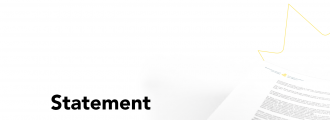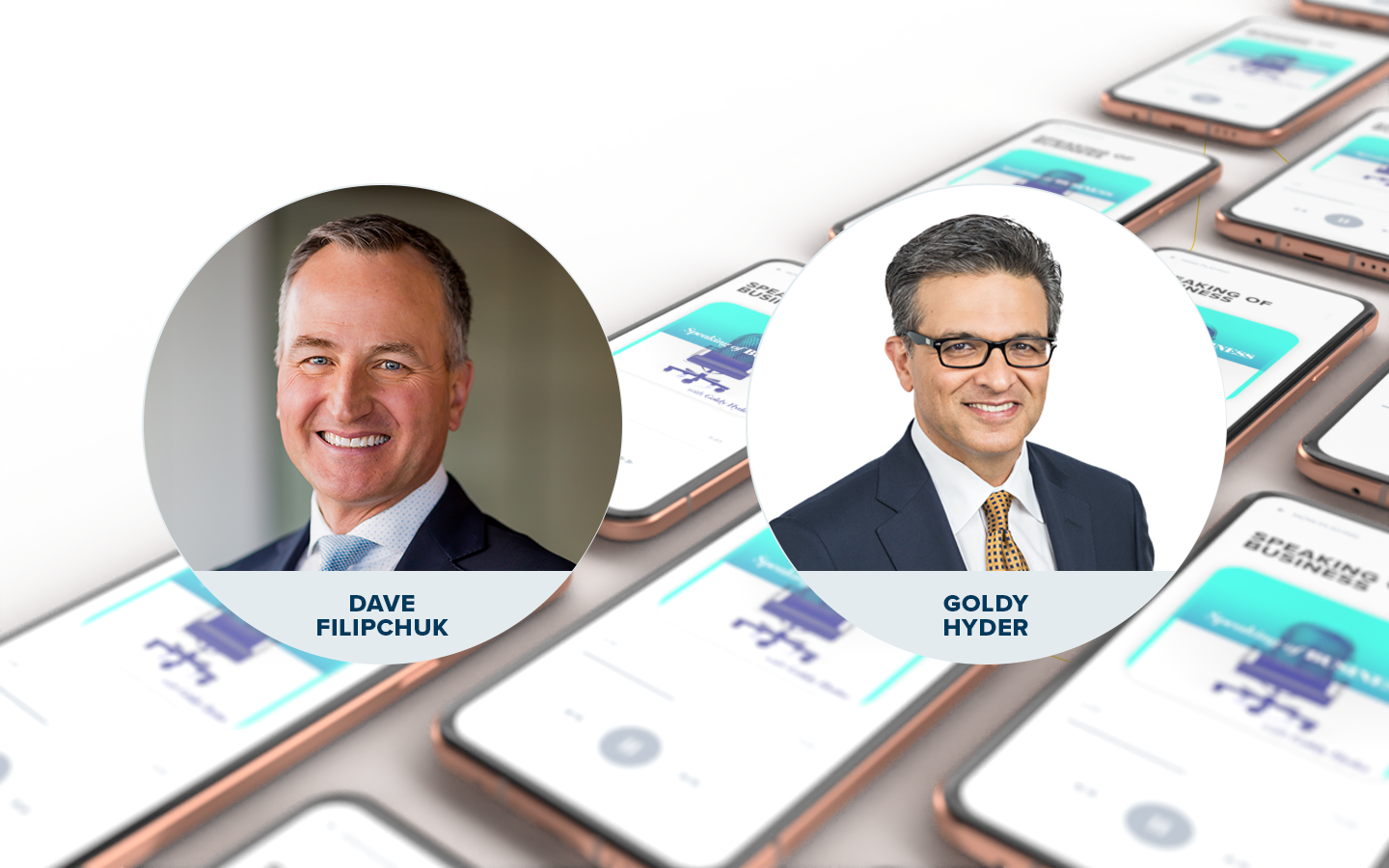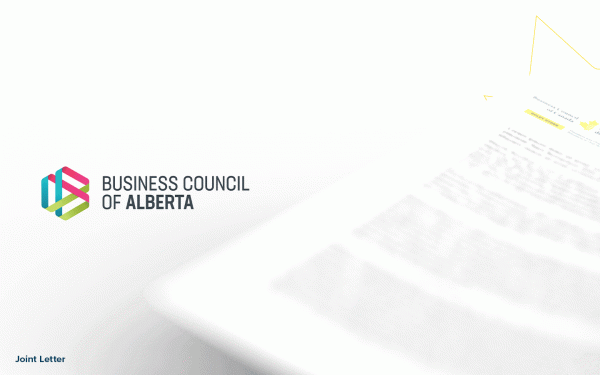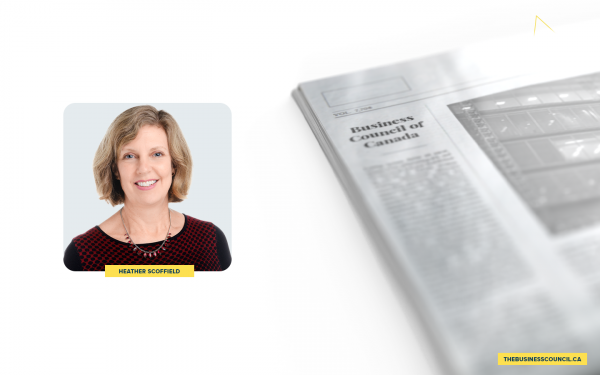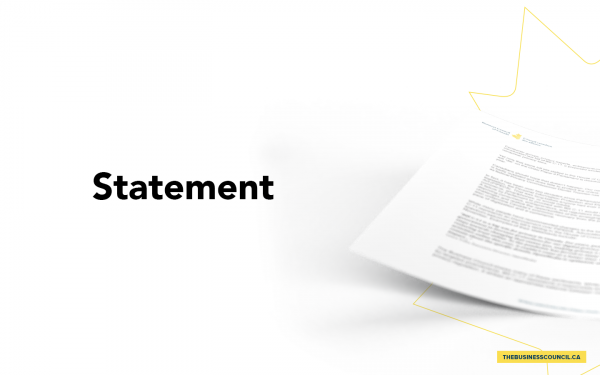Building a better future
When Dave Filipchuk began working in the construction industry in the 1980s, digital technology was just a blip on the radar screen.
Times have changed.
“We’ve got an internet-of-things evolution happening in our industry,” says the President and CEO of PCL Construction, Canada’s largest general construction company. “It goes way beyond measuring things like temperature and humidity. [It includes] air pressure, sound levels, concrete strength, vibration – all with internet-connected sensors in our buildings as we build them.”
“We all know the value of working together and the relationships that can only develop well through in-person interaction …Even companies that are moving towards some form of hybrid model still need spaces to come together.”
Dave Filipchuk, PCL Construction
Modern building design and engineering also has to take into account climate change. For companies like PCL, that includes using low-carbon, energy-efficient products and materials, sourced locally when possible. Buildings must also be capable of withstanding extreme weather events.
For all the changes, Filipchuk says the fundamentals remain the same. “I often talk about it as the food, clothing and shelter business,” he says. “We meet the needs of human existence going into the future. How we do things will evolve, and we’re going to need to adapt in smart ways to define that better future for our kids and the generations after us.”
Listen to Dave Filipchuk’s conversation with Goldy Hyder on the Speaking of Business podcast.
Latest Podcasts
Transcript
Dave Filipchuk:
I often talk about it as the food, clothing and shelter business. We meet the needs of human existence going into the future, and we’re going to need to adapt in smart ways to define that better future for our kids and the generations after us.
Goldy Hyder:
Welcome to Speaking of Business, conversations with Canadian innovators, entrepreneurs, and business leaders. I’m Goldy Hyder of the Business Council of Canada. How many times have you heard the words “build back better” over the past year? It’s become a favorite catchphrase of politicians frankly all around the world as they look towards the post pandemic recovery. But long before COVID, the idea of “building back better” was central to the work of my guest today. Dave Filipchuk is President and CEO of PCL Construction. For more than a century, the Edmonton-based company has been at the forefront of literally building a better future. Today more than 4,500 employees are focused on construction, innovation and cutting edge technology with projects in Canada, the United States, Australia, and the Caribbean. What does “build back better” mean to Dave Filipchuk? Welcome to the podcast, Dave.
Dave Filipchuk:
Thanks, Goldy. Great to be here.
Goldy Hyder:
All right. Let’s jump right into it. I mean, what does the “build back better” future look like to you?
Dave Filipchuk:
Well, it speaks to what we call our purpose here at PCL. So many in our company and across our industry love this about our work. We build the places where people live, work and play. We cover very large geography, but our projects are all local serving our communities. And so, so many great examples of employees that can live their purpose. Raving hockey fans that get to build their team’s arena in their home city. People with aging parents that are building hospitals, long term care centres, and so many other things like that. We get employees to tell their stories on something we call “Purpose Unpacked Spotlights,” and they can share their connection to our purpose. We hear people saying things like having their kids, sharing stories, “My dad built this. My mom built that.”
Dave Filipchuk:
We get a real sense of accomplishment from what we do in the super tangible business for sure. I often talk about it as well, Goldy as the food, clothing and shelter business. We meet the needs of human existence going into the future and I think that’s going to be here indefinitely. For sure how we do things will evolve and we’re going to need to adapt in smart ways to define that better future for our kids and the generations after us.
Goldy Hyder:
Well, I’d read in the Edmonton Journal, you had said that construction is a very purposeful pursuit that you’re building a better future together and your answer there just captures that in a nutshell. But I also saw that, I mean, first of all, PCL is an employee owned company and this whole notion of purpose seems to be more topical these days especially with the next generation. But it sounds like the purpose piece has been deeply embedded in PCL for some time that when in fact Ernest Poole who was the founder of the company, sold it to his sons. He wrote a list of principles I read, which have become known as sort of Poole’s Rules. And those values include being firm, fair, friendly, and ensuring the company’s word was as good as its bond. Are you holding up to that?
Dave Filipchuk:
For sure. In fact, you travel to our offices and you’ll see employees having Poole’s Rules posted up in their offices on their walls. And I’ll say it’s a credo that many of our employees still live by to this day. And our employee ownership model is a big, big part of that. We call ourselves a family of companies and we mean it. And people act that way and their actions and living their purpose really are driven by family values.
Goldy Hyder:
Now, of course, values come up against a wall sometimes for many, when you have to manage a crisis. How have the values helped you manage the crisis if you will, particularly the fact that in your business, there’s really two components of work? There’s people who come to work like you do and dress up and sit in an office. But then I assume the vast majority of your workforce is not in that situation. How have you managed that and been fair to both of those groups?
Dave Filipchuk:
Sure. Well, we were fortunate as a business compared to many others with construction being an essential service through the pandemic. So, what that meant for us is that when we were required to work from home, those that could did. However, we had essential employees going to the job sites every day. And that makes up 60 to 70% of our workforce. And they were really on the front lines continuing to do what was needed. So, we are very much a collaborative, work together organization. It was important for us to do what was required at critical times during the pandemic, but then also bring our people back into those collaborative environments as soon as it was safe to do so. We often talk about the rift between the office and the field. And the only way you could make that worse would be to have people in the office, not even have to go to the office anymore. So, we were certainly eager as our employees were as well to get back into our workplaces, collaborate and do those things that employee owners want to do together.
Goldy Hyder:
I’m going to come back to that. But before I do, you said something that I want to explore a little bit further. You said that you were an essential service. That’s true, but not necessarily everywhere in this country. What did you learn about Canada and what are some of the lessons we should take away to help our governments realize that it’s complicated to have essential services defined as one thing in one province and another thing in another?
Dave Filipchuk:
Certainly, we had to be nimble. We are one company and we try to conduct ourselves that way. We had to be respectful of local differences that were many through the pandemic, for sure. So, what can governments learn from that? Certainly it would’ve been better for us as an industry to manage our businesses if there was a more unified approach across borders, provincial borders on how we would manage through the pandemic. But that said, even within some provincial jurisdictions, there were disparities between public projects and private projects that were difficult to figure out in the moment. We had to follow those guidelines. I’d say that a more unified approach across provincial borders would’ve been better for our industry as a whole Goldy.
Goldy Hyder:
Well, I hope they’re listening, Dave, because you had to run one PCL, but times I thought we had to run 13 Canada. So one, Canada’s the message in our next crisis. I like it. Now let me come back to, you talked about your own impact in terms of return to work, but you’re in the construction business. So, how has this changed or has it changed the way buildings are going to be designed and constructed? I mean, do you now find yourself thinking differently about space and how people interact or is it short term that’s maybe the case, but you really think overall it’s, we’re going to be right back to where we were?
Dave Filipchuk:
Yeah, that’s a great question. So, 20 months in it’s really too early to know what the lasting effects are truly going to be in our own business. As I mentioned, we’ve been fully back in our workplaces across our footprint for quite some time. And that is important for us with the nature of the construction business, the need to collaborate and the fact that people on our job sites keep going to work no matter what. Now, the type and amount of space required may evolve over time. We all know the value of working together. At least, we in our business do. And the relationships that can only develop well through in-person interaction, you really can’t replace that. Even companies that are moving towards some form of hybrid model, still need spaces to come together, to train, to develop, to have their cultural collaboration happening.
Dave Filipchuk:
And so, my own view is that the pendulum’s going to swing back towards valuing those collaborative environments. There’s going to be some form of de-densification of space, I think, perhaps for some fewer full time in the office, but more space per person. So, you may have somewhat of a leveling effect that similar amounts of space are still going to be required. There’s going to be trends in design towards greater attention on air filtration, improved circulation, those sorts of things that have been a topic for airborne diseases. And I just would say, we’re going to continue to live through cycles of more or less space required. But my view space needs are going to continue to be here for the long term.
Goldy Hyder:
One of the things that I know you’ve been talking about and you and I are speaking for the benefit of the listeners right when COP is going on, and this whole, the importance of climate change, you were actually ahead of it. You were talking about the concept of resilient buildings for quite some time. What do you mean by resilient buildings?
Dave Filipchuk:
In all areas of society, much can be done to lessen our environmental impact, I’ll start there. In our industry, building more efficient, lower impact buildings is how we do that including retrofitting aging stock that’s out there in our downtown cores. Now at the same time considerations being given to more extreme weather events that are happening, heat, cold, wind, fire, things that are affecting our communities in increasing ways. Resilient building leans into both of those concerns. So, ways we address that are through things like low carbon materials, energy efficiency in design, maximizing natural lighting, flexibility of use in building space using more durable and robust materials, local sourcing, local materials and products and lower energy input during construction are some of the ways that we do that.
Dave Filipchuk:
We have business units across our company that are specifically focused on retrofitting to reposition aging assets in those downtowns that I mentioned. Also Goldy, today most builds are guided by widely accepted certifications. One of those is LEED, Leadership in Energy and Environmental Design. And most of our clients target LEED gold or platinum levels at this time. They expect it, their end users, their tenants expect that. That’s for environmental efficiency and our own builds. When we are building PCL space, we do the same.
Goldy Hyder:
There’s got to be a cost to all of this though, right? How are you and your customers managing the transition? And what’s the relationship like with government because you talked about the importance of regulatory stability and so forth?
Dave Filipchuk:
The cost has become less of an impact on these Goldy over time. There are smart ways to do it where certainly many decisions that are made during design development can drive cost one way or the other. And I think we’re finding more and more ways where this is simply a baseline expectation of the tenants that are going to occupy the space and clients aren’t in a position right now where they’re going one way or the other on, do we do this or don’t we do it? There really is no choice. We’re only going to build buildings that have that capability. And therefore we’re going to do that in the most cost efficient way possible. And that’s part of our job is providing options and coaching our clients for ways to accomplish those requirements to satisfy their tenants.
Goldy Hyder:
One of the things that I was struck by in preparing for this is your own career story. And part of what we like to talk about on this podcast is leadership and your journey there. You’ve been with PCL for almost four decades. You landed a job with the company pretty much after completing an engineering degree. You think in today’s world it’s still possible to do that, to work your way up in a company the way that you’ve done?
Dave Filipchuk:
I do. And I’ll tell the short story here. I mean, I was super fortunate in the early ’80s considering the shape of Alberta’s economy at that time to get a job right after graduation from engineering and doubly fortunate at that time, I’ll say to join a company with an employee ownership model already in place. That was there since 1977. So, now we’re 44 years into that employee own model. 100% of the company is owned by employees and you have to be an active employee to have a stake in our company. And that is, I believe one of the reasons that we enjoy many long tenured employees, including myself here. So, one of my predecessors in this role, Bob Stollery was one of the original employee owners and his mantra was “sharing is good for business.”
Dave Filipchuk:
That continues to be a real key driver of our culture, the tremendous sharing, the support, the helper culture, the high engagement that comes from being a group of owners. So, I absolutely see it as possible to continue to build long careers, to grow our leadership talent from within. And in my own experience, there was such great variety in this job, kept it fresh and interesting. I went through different paths down into the U.S. on a couple of occasions, 10 years in the civil infrastructure side of the business. So, honestly it’s felt like a number of different jobs over time. You might get a sense that mobility is big in our business.
Dave Filipchuk:
It sure is, going to where the work is, moving to hotter markets, leaving cooler markets. And that is always a great way to stretch your experience and gain new experiences. We have a long time peer of ours in this business, EllisDon, who is also our joint venture partner on the Centre Block Project. And they have recently gone to an employee ownership model and I predict good things for them from doing that. And I think that there’s great value in more and more organizations in our industry and other industries to move to that model.
Goldy Hyder:
I can’t argue with that coming out of a family business, pretty much a similar concept when you think about it, right? It’s share the responsibilities and the benefits. One of the things that CEOs are seized with, you know this and right across this country, it doesn’t matter what industry is the issue of skills and labour shortage and mismatch of skills and labour shortage. I’m wondering what you think can be done about that. And what is the role sort of the private sector and employers to help colleges and universities graduate the workforce that we need for the future?
Dave Filipchuk:
Sure. It’s an important topic for all industries and ours, for sure. We’re constantly recruiting from universities, colleges, polytechnics and are needing good talent. There’s always room for improvement on that alignment between what industry needs and what post-secondaries are delivering. Not surprisingly, our industry targets a lot of STEM graduates. And so, we’re advocating for more STEM content. However, we hire from a wide range of faculties all the time. Our highest level of success in hiring for fit into our company is through our student program. So, in Canada alone, we place over 600 students annually in our business. They learn about our business. We learn about them. And very often they’re the ones that convert to permanent hires following completion.
Dave Filipchuk:
One of the ways that we try to improve the alignment between us and the post-secondaries, we have employees stay connected with their alma maters and go in and do guest lecturing volunteer their services to help out in construction related fields within those. I think that’s a very positive thing and there’s always room for improvement Goldy, but I think there’s been some good progress over the past while on that front.
Goldy Hyder:
Now, one of the things that employees are expecting however is, listen, you want me to stick around with you and clearly you do. What are you doing to invest in my education long after I’ve graduated long after I’ve left sort of college and university? And so, what’s the role of employers and are you seeing evidence that employers are seeing the responsibilities of training, retraining, reskilling as something that they also need to take the lead on?
Dave Filipchuk:
There is a big ongoing responsibility for that. And I’ll say we put a lot of energy into this at PCL and others do as well. This is both on the technical side and behavioral side of that skill continuum. For decades, we’ve had our PCL College of Construction for our own employee base. That’s our internal mechanism for continuously delivering professional development for our people, everything they need to grow in advance in the organization. We also have our PCL Leadership Academy within the College of Construction, and that’s helping everyone develop the leadership behaviors through personal growth and transformation. So, we’ve got something we call our E3 Leadership Certification Program Goldy, and that E3 stands for education, exposure and experience. And all three of those are critical for leadership development in our company and in others. We model this after university style courses, E3 100 level and 200 level available. Our 300 level is under development currently.
Dave Filipchuk:
And we also I’m off here in a week’s time to our week long leadership course. Annually, we put 35 individuals in our organization, future leaders. They’re honing their skills in the leadership realm. One last point here, just this week, I also approved our communication for 50 behavioural training sessions that are scheduled for our fiscal year here that just commenced November 1st. So, these are online and in person internal courses specifically for behavioural training that we put hundreds of individuals through every year.
Goldy Hyder:
Pre-COVID, I would say that one of the things that was going on in the business community writ large was really the digitization and the impact of digitization and the digital transformation that we’re all witnessing. And it’s having an impact on the things we’ve just talked about, the skills and the kind of people that you’re hiring. When you think about construction, you often think about what kind of digitization is happening there? I mean, after all, we’re talking about building things. So, surely to goodness it’s happening. Tell us, tell the listeners what is happening in the construction industry as it relates to the impact of digital?
Dave Filipchuk:
Yeah, for sure. Our industry is having lots of tech deployment in many, many ways and I’ll share some of that. Things like leak detection, putting sensors everywhere. We’ve got an internet of things, evolution happening in our industry. And this is going way beyond measuring things like temperature and humidity, but air pressure, sound levels, concrete strength, vibration all with internet connected sensors in our buildings as we build them. Great example that I heard recently on our projects is pressure sensors in our healthcare work. There’s a requirement to have negative air pressure, they call it for infection control.
Dave Filipchuk:
And we can now have those sensors and monitor that 24-7 and be sure of safe protocols during our healthcare work. So, there’s really tremendous risk mitigation opportunities that come about with all of the new technology that’s out there. Leak detection systems that will automatically shut off valves if you have a leak developing somewhere. We’re advocating for these sensors to be used during the construction period, but also left in there for the permanent operations of the buildings as well and that is happening in many cases. Now this also ties back into earlier discussions around the environmental performance of buildings and trying to continuously improve on that. For sure, using sensors can minimize waste and reduce carbon. We have that ability to monitor spaces. So, we’re not overheating, overcooling. Things don’t have to run 24-7.
Dave Filipchuk:
You can be turning them on and off automatically through technology. Lots of data being collected that won’t surprise you. We have a product called Job Site Insights, which was developed inhouse and is now being marketed in a partnership with Latium Technologies for broader use across the industry. It’s gone beyond being a PCL only product and it’s being now marketed to third parties as well, Goldy. Aon Risk Solutions is a partner in that with us. It’s being used in U.S. operations with other contractors, also off in Europe. And we’re going to continue to try to share that more broadly in the industry. I’ll share one last thing here. We don’t have formal R&D labs but we have hundreds of labs every day. It’s where our R&D happens is off on the work face. And the trick for us is capturing all of those great ideas and effectively communicating those innovations right across our footprint.
Goldy Hyder:
Now, look, we’ve covered off COVID. We’ve talked about skills, we’ve talked about the climate. One of the other issues that’s very prevalent in society today is the issue of diversity and inclusivity. And this may be a perception, but would it be fair to say that the construction industry has some work to do on that issue?
Dave Filipchuk:
Yeah. I’d say we have underleveraged the whole population. I think that’s something back to talent needs in the organization that we are focused on doing much better on as a company and as an industry. One of the specifics Goldy, we’ve company-wide, every employee over the past 18 months has gone through unconscious bias training in order to sort of address some of the low hanging fruit out there. I mean, there’s no need for us to not be openminded about working effectively with the whole population. And I think it’s a missed opportunity for us over time. So, it’s not a wrong historical perception of the industry, but I’d say good work is being done to advance that and to do better. And I think we’re going to continue to do better.
Goldy Hyder:
Yeah. I think a lot of these issues are just good business, aren’t they?
Dave Filipchuk:
They are.
Goldy Hyder:
You mentioned your footprint, if you will, is not just in Canada, but it extends into the United States and in Australia. I’m wondering as a Canadian company that’s trying to compete internationally, what’s necessary to be successful on the global stage?
Dave Filipchuk:
Well, we certainly have our roots here in Canada, but have been international for some time. And the way that that has typically started for us Goldy, is a client taking us there. So, we first entered the United States with Oxford, our client in 1975. And then in the U.S. grew from there adding locations, branching into other sectors into the civil business, into the industrial business from that early start. And construction’s a cyclical business for sure. And having geographic diversity and sectoral diversity is one of the defenses against those cycles and managing through the cycles of construction. So, we’re very, very grateful to have that. Our growth into Australia initially was through our Canadian P3 Healthcare experience, having built public private partnership hospitals here, and then taking that and doing the Victorian Comprehensive Cancer Centre and in Melbourne Australia. Now we’re back in Australia with three major solar projects growing our footprint again there. What does it take to succeed?
Dave Filipchuk:
I’ll say, the US continues to be a highly competitive market that won’t surprise anyone. A land of opportunity, a land that we want to grow in, but a highly contested market. So, we need to be very strategic about where we are and the markets that we pursue and do that in a way that’s going to work well for PCL. And it takes an investment of time to build a local reputation in those areas as well and we’ve committed to investing that time. So, there’s no secret sauce here, but it’s rather an investment of time respecting what has made us successful in Canada and deploying many of those same skills internationally.
Goldy Hyder:
I find it interesting that you referenced Australia. Just pre-pandemic, my last international trip was to Australia and it was in part to do some research, if you will, on why is Australia doing such a great job with infrastructure? And I got all the way across the ocean to learn that they basically got their prototype from Infrastructure Ontario. And the difference between them and us seems to be two things. One is they do things of scale, and secondly, they do things, they build things. I’m wondering if you feel that growth and infrastructure is hard in Canada, that it’s getting difficult to build things.
Dave Filipchuk:
Yeah. I mean, the needs are great and there’s been attempts to deliver increasing amounts of infrastructure over the past years. For sure what’s happened, the trend has been towards larger and larger bundled infrastructure deals that are not accessible to a wide range of contractors due to their size due to the risk profile of those projects and in part due to the ongoing desire of the contracting agencies to build a better mouse trap to continue to improve the risk transfer mechanisms that place it all back on those in the construction industry. And we’ve always advocated widely Goldy for a model that puts the risk in the hands of the party best able to manage the risk. We are in the risk management business. That’s what we do every day. And we are happy to take on those risks that we can quantify and manage and do so through our experience.
Dave Filipchuk:
But taking unknown subsurface risk for foundations, taking the risks of the unknown is not something that keeps you a contractor, it makes you a gambler. And those are things that we are wanting to avoid. And we advocate for risk models that continue to allocate risk in meaningful ways to the party that can best manage it.
Goldy Hyder:
Lot of wisdom in that answer. And I think a lot of things that might be in the public interest, if we let those who do what they do best do it and facilitate that and have a oversight. Look, let’s wrap up and circle back to where we started and the notion of building a better future together. Rebuilding from the pandemic is going to take a lot of good will and some creative thinking. And in that spirit, the question that I’ve been asking our guests in this season to conclude is what’s one big idea that you think could help transform Canada?
Dave Filipchuk:
Thanks, Goldy. Really what I want to do is reinforce a big idea that’s already underway. That’s the Coalition for a Better Future that was launched by the Business Council of Canada. As you know, PCL has our purpose building a better future together. That’s driven by all of us as employee owners, embracing an ownership mindset. What that does for us is takes down silos, enhances collaboration across borders, increases caring and sharing as you’d expect. And as a country, we can embrace that ownership mindset as well. We just came through a federal election where there was little to no focus on economic growth, it just didn’t come up. There’s certainly lots of needs and wants that are out there and the way to support that is through solid economic growth.
Dave Filipchuk:
So, one very important thing that the Coalition can do is communicate the importance of leveraging all of our existing strengths as we go through a necessary energy transition in this country. I want to see us keep investment flowing to enable that research and development that’s going to deliver solutions locally that are going to have the greatest global impact. So, that’s the big idea that I want to support today, Goldy.
Goldy Hyder:
Well, thank you so much for that, Dave. I think there’s, again, a lot of wisdom in that. And for listeners, if you want to learn more about the Coalition for a Better Future, that’s Canadacoalition.ca and I think you’ll learn more about what Dave just talked about. But just to bring it all home, we all talk about the #buildbackbetter. But the other one that was prominent throughout this pandemic, and I really think captures what Dave just said is in this together. And if we are really all in this together, then that means we have to work together. So, what a great place to wrap. Dave, thank you so much for making the time today and sharing your insights and your wisdom and appreciate your leadership across this country.
Dave Filipchuk:
My pleasure. Thanks Goldy.
Goldy Hyder:
Dave Filipchuk is President and CEO of PCL Construction. In our next episode, we’re going to stay in my home province of Alberta, driving south to Calgary and the headquarters of Shell Canada. I’ll be speaking with new president, Susannah Pierce, about climate change and Canada’s energy transition. Here’s a preview.
Susannah Pierce:
The amount of technology investment that is happening right now to decarbonize the amount of investment that big players are making in carbon capture sequestration, for example, the opportunities that we see in renewable fuels, whether that’s waste to energy, whether that’s biofuels. What I am optimistic about is the energy sector is changing from one of being carbon intensive to one of being more clean energy.
Goldy Hyder:
Please join me in two weeks to hear this important conversation with Susannah Pierce. Remember if you would like to hear more of our Speaking of Business conversations with innovators, leaders, and entrepreneurs, why not subscribe to our podcast. Search for Speaking of Business, wherever you get your podcasts, or simply go to our website at thebusinesscouncil.ca that’s thebusinesscouncil.ca. Until next time, I’m Goldy Hyder. Thanks for joining us.

